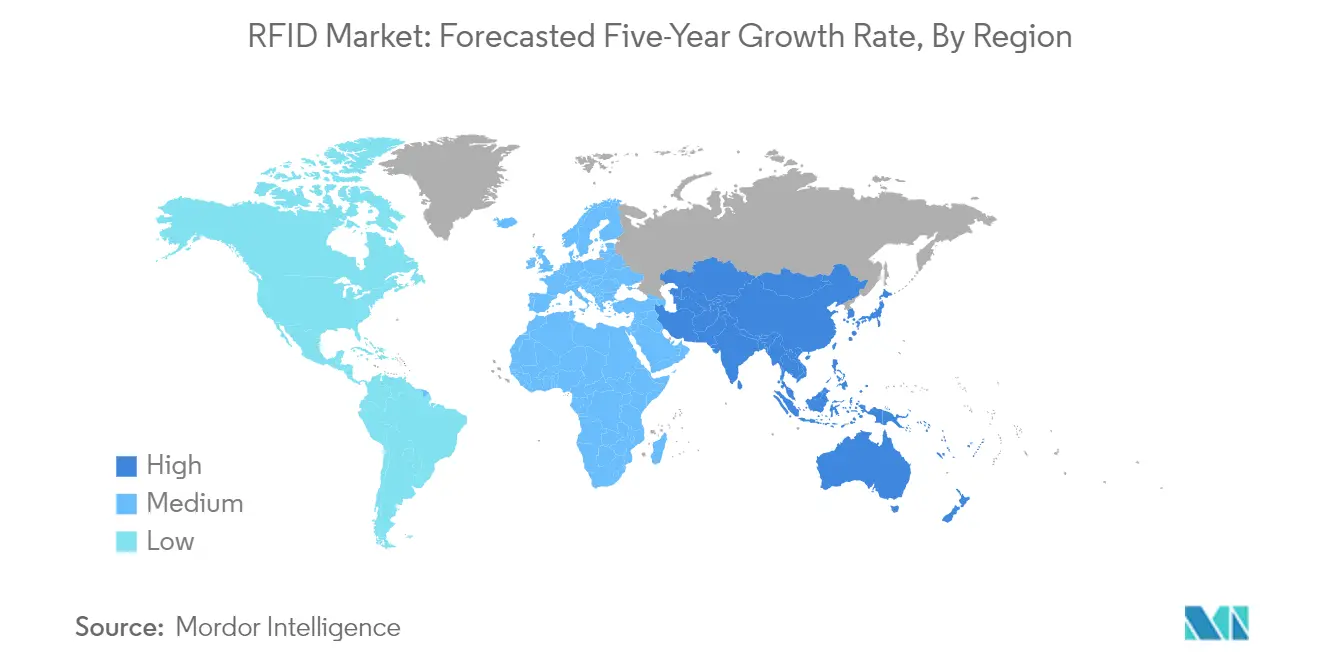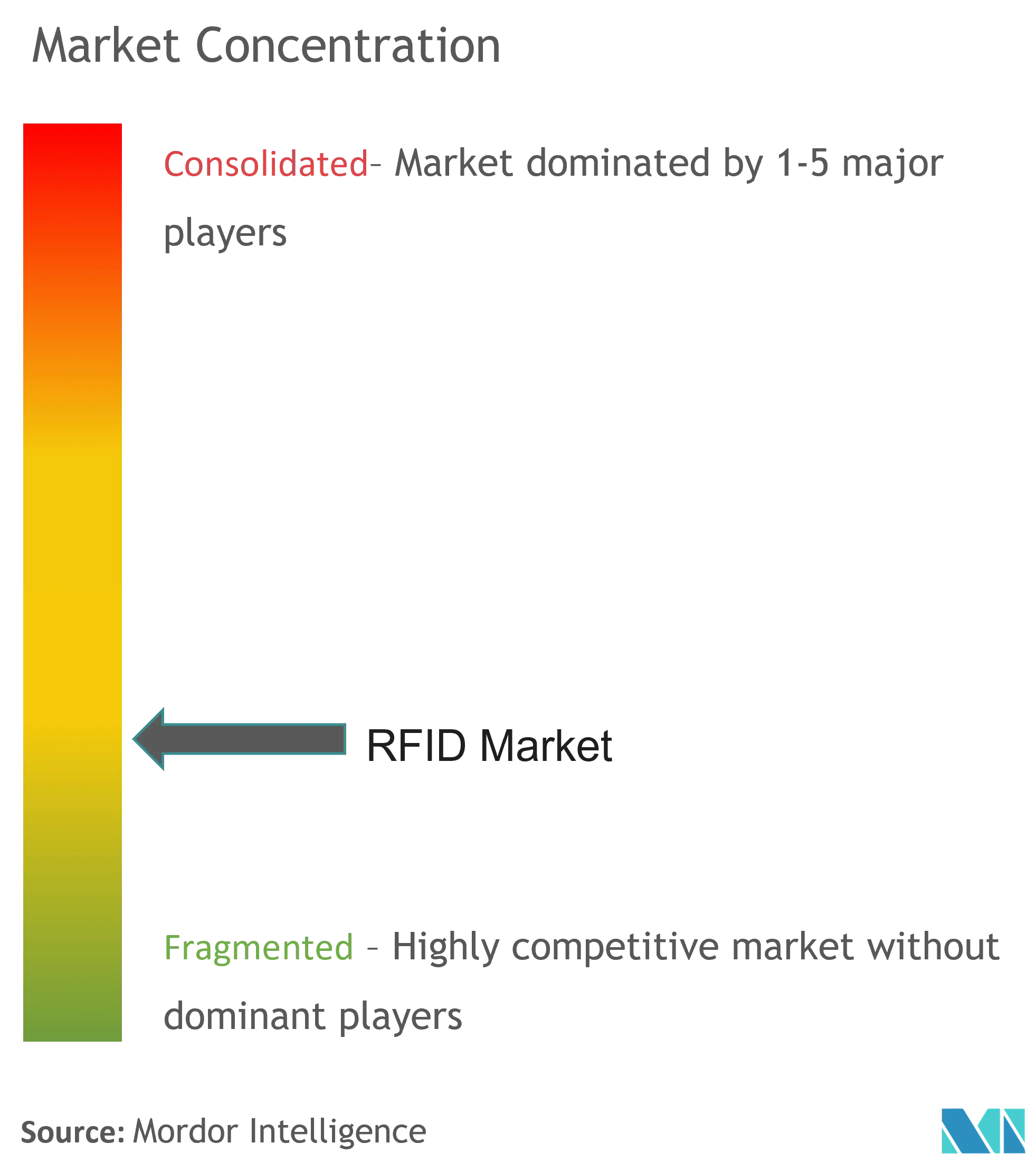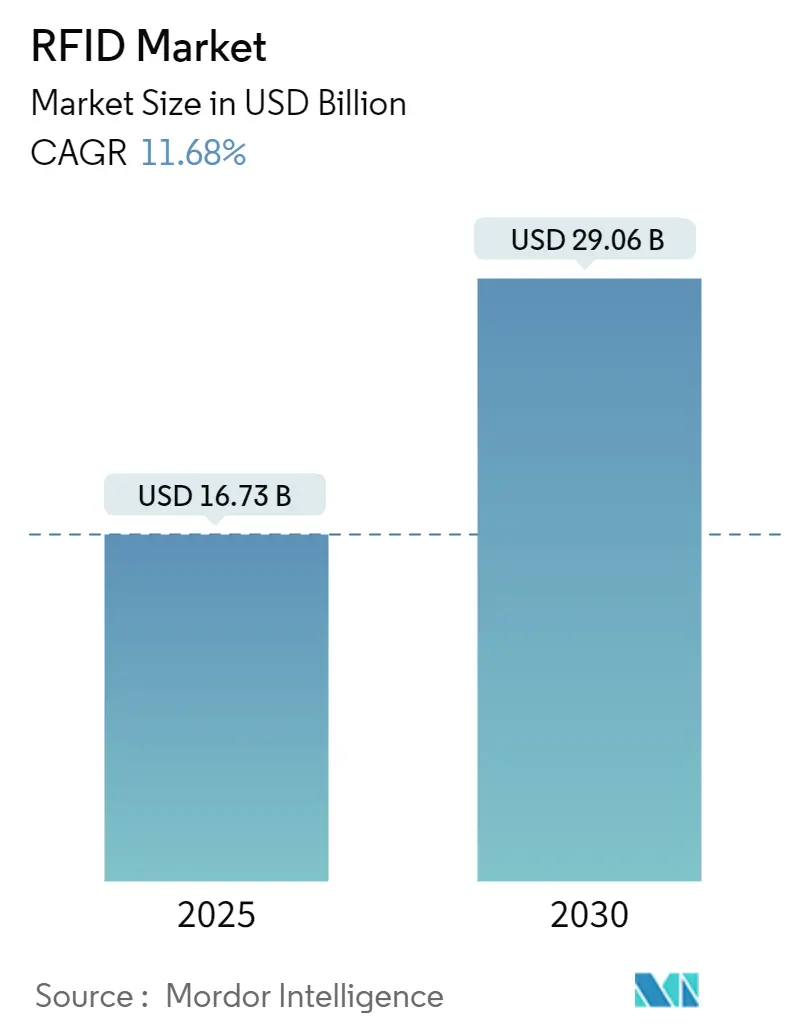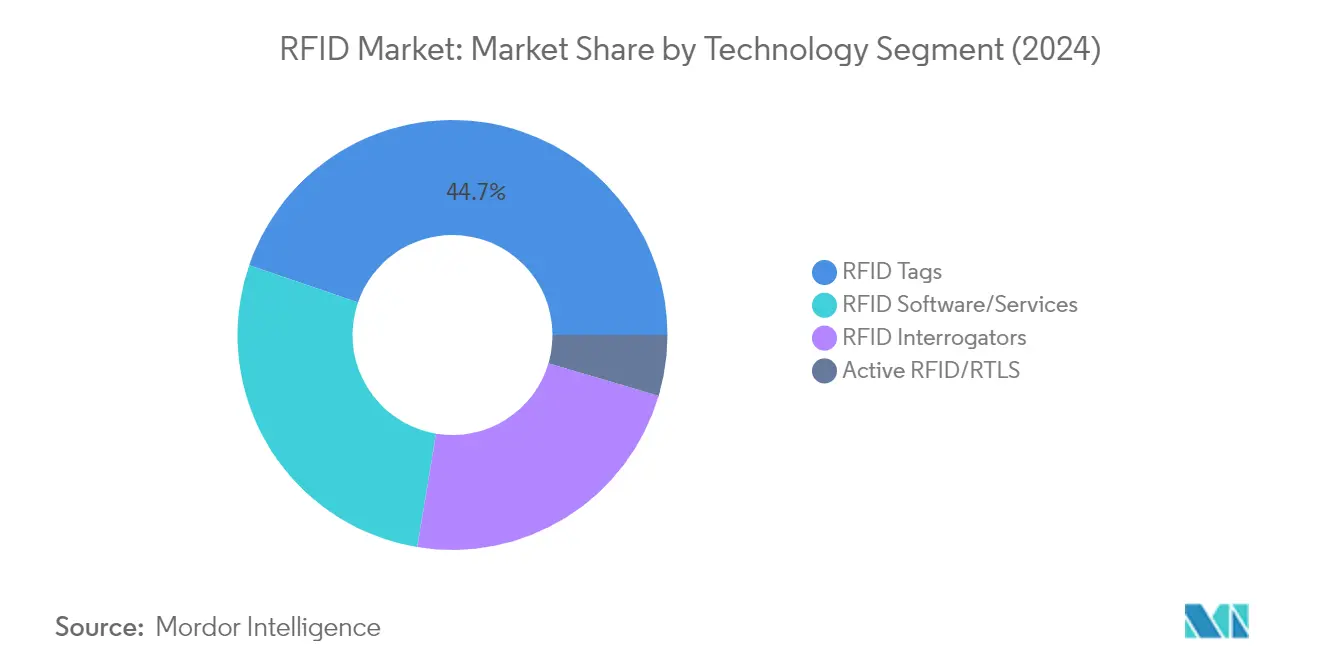RFID Market Analysis
The RFID Market size is estimated at USD 16.73 billion in 2025, and is expected to reach USD 29.06 billion by 2030, at a CAGR of 11.68% during the forecast period (2025-2030).
The RFID industry is experiencing significant transformation driven by the broader digitalization of global supply chains and retail operations. Annual retail sales in the United States reached USD 5.13 trillion in 2023, highlighting the massive scale of operations that require advanced RFID solutions for tracking and inventory management. Major retailers are increasingly mandating RFID adoption across their supply chains, with Walmart expanding its RFID requirements for suppliers looking to get their products on store shelves. This shift towards mandatory RFID implementation is reshaping supplier relationships and driving widespread adoption across the retail ecosystem. The integration of RFID technology with emerging technologies like cloud computing and artificial intelligence is enabling more sophisticated inventory tracking and loss prevention capabilities.
The healthcare sector has emerged as a significant adopter of RFID technology, with the ASHP Foundation's 2022 report indicating implementation in approximately 40% of healthcare organizations. These implementations have demonstrated remarkable improvements, including an 82% enhancement in inventory tracking capabilities and a 72% reduction in expired medications. Recent innovations in the field include sustainable solutions, exemplified by Avery Dennison's launch of the AD Pure range in September 2023, introducing a portfolio of entirely PET plastic-free RFID inlays and tags. This development addresses growing environmental concerns while maintaining high performance standards for applications across clothing, retail, industrial, and supply chain sectors.
The convergence of RFID with Internet of Things (IoT) technologies is creating new possibilities for asset tracking and management. The number of IoT connections is projected to grow from 15.7 billion in 2023 to 38.9 billion by 2028, indicating the expanding ecosystem in which RFID technology will operate. This integration is evident in recent industry developments, such as McDonald's China's January 2024 partnership with Cainiao to implement RFID technology across its supply chain, enabling real-time tracking from factories to restaurants. The technology's application is becoming more sophisticated, as demonstrated by Metalcraft's November 2023 launch of the Universal Eco Mini RFID Tag, which achieves a read range of up to 25 feet on metal surfaces while using 40% less material than legacy products.
The industry is witnessing a surge in strategic partnerships and technological innovations aimed at enhancing operational efficiency and customer experience. In January 2024, Nedap's partnership with Pacsun to implement RFID across its store fleet exemplifies the retail sector's commitment to improving inventory accuracy and delivering data-rich insights for operational processes. The evolution of RFID technology has expanded beyond simple tracking to include advanced applications such as automated checkout systems, smart fitting rooms, and integrated supply chain management solutions. These developments are driving the adoption of RFID across various industries, from retail and healthcare to manufacturing and logistics, as organizations seek to improve operational efficiency and enhance customer experience through better inventory management and supply chain tracking.
RFID Market Trends
Government Policies Favoring Digital Development
Government initiatives and policies worldwide are increasingly supporting the adoption of RFID technology as part of broader digital transformation strategies. For instance, under economic diversification strategies like UAE Vision 2021, Abu Dhabi Vision 2030, and Dubai's Industrial Strategy 2030, the development of the logistics sector incorporating logistics RFID technology has been identified as a crucial strategic goal. The Federal Competitiveness and Statistics Authority anticipates logistics to contribute 8% of the economy in 2021, rising significantly from 5.4% in 2017, demonstrating the impact of such government support. Additionally, the Japanese government's initiative announced in 2023 to promote retail RFID automation through RFID technology, involving five major convenience store chains to implement RFID tags on all their products by 2025, showcases how government policies are driving digital transformation.
The growing government support for digital technologies, including Big Data and the Internet of Things (IoT), has created significant opportunities for RFID market expansion. For example, in February 2023, the Delhi Municipal Council's decision to integrate its RFID toll collection system with the National FASTag system demonstrates how government policies are facilitating digital infrastructure development. Similarly, in July 2023, Indian Railways' implementation of RFID technology for automatically reading freight yard wagon numbers through the Freight Operations Management System illustrates how government initiatives are driving RFID adoption in public infrastructure. These policies not only enhance operational efficiency but also create a foundation for future technological advancement and economic growth.
Increasing Installation of RFID in Manufacturing Units for Productivity Improvement and Security and Access Control Applications
The manufacturing sector is witnessing a significant surge in RFID technology adoption, driven by the need for enhanced productivity and improved security measures. In September 2023, Zebra Technologies Corporation's research revealed that 58% of warehouse decision-makers plan to deploy RFID technology by 2028 to increase inventory visibility and reduce out-of-stocks. This trend is further exemplified by the growing implementation of RFID solutions in manufacturing facilities for real-time tracking of components, automated inventory management, and enhanced security protocols. The technology's ability to provide visibility of products, spare parts, inventory, and complete work status across entire factory floors has made it an essential tool for manufacturing operations.
The security and access control applications of RFID technology have become increasingly crucial in manufacturing environments, leading to widespread adoption across various industrial sectors. For instance, in December 2023, Laxen Technology's investment of 500 million CNY in an 8-12-inch wafer RFID chip packaging and IoT intelligent terminal manufacturing base demonstrates the growing focus on security-enhanced RFID solutions. The integration of RFID systems with warehouse management systems has shown to lower operating costs and increase speed and accuracy, with manufacturers reporting significant improvements in productivity. The technology's ability to track and trace critical industrial components in automotive manufacturing processes, ensure efficient monitoring, and maintain secure access control has made it an indispensable tool for modern manufacturing facilities.
Segment Analysis: By Technology
RFID Tags Segment in RFID Market
The RFID tags segment continues to dominate the global RFID market, commanding approximately 45% market share in 2024. This significant market position is attributed to the widespread adoption of RFID tags across various industries, particularly in retail and supply chain management. RFID tags are increasingly being utilized for inventory tracking of merchandise, vehicles, and patients, offering smart label capabilities that enable efficient identification and monitoring. Major retailers and manufacturers are implementing RFID tag solutions to enhance their inventory management capabilities and improve supply chain visibility. The segment's growth is further supported by continuous innovation in sustainable and high-performance RFID tags, with companies like Metalcraft and Avery Dennison launching eco-friendly and specialized tags designed for specific industry applications.
Active RFID/RTLS Segment in RFID Market
The Active RFID/RTLS segment is emerging as the fastest-growing technology segment in the RFID market, with a projected growth rate of approximately 14% during the forecast period 2024-2029. This remarkable growth is driven by the increasing adoption of IoT devices and the growing sophistication of real-time asset tracking and tracing capabilities. Active RFID technology is particularly gaining traction in healthcare, manufacturing, and logistics sectors, where real-time visibility of assets is crucial for operational efficiency. The segment's growth is further accelerated by the integration of sensor-enabled battery-powered RFID tags that can create and transmit metrics and other data in real-time, making them truly smart and expanding their capabilities in connected device ecosystems. The technology's ability to maintain asset visibility 24/7/365 is helping organizations improve their bottom line, save lives, mitigate hazardous events, and reduce liabilities.
Remaining Segments in RFID Technology Market
The RFID market's technology landscape is further complemented by RFID reader and RFID software/services segments, which play crucial roles in the overall RFID ecosystem. RFID readers, also known as interrogators, serve as the primary communication bridge between RFID tags and backend systems, offering both fixed and mobile solutions for various applications. The RFID software/services segment provides essential data processing capabilities, system integration, and specialized applications for supply chain management, enterprise resource planning, and warehouse management systems. These segments continue to evolve with technological advancements, offering enhanced features such as improved read ranges, better data processing capabilities, and more sophisticated software solutions that cater to specific industry requirements.
Segment Analysis: By Application
Retail Segment in RFID Market
The retail segment continues to dominate the global RFID market, commanding approximately 29% market share in 2024. This significant market position is driven by the widespread adoption of RFID technology for inventory tracking, supply chain optimization, and enhanced customer experience in retail environments. Major retailers worldwide are implementing RFID systems to streamline their operations, with applications ranging from automated inventory tracking and stock management to loss prevention and seamless checkout processes. The technology's ability to provide real-time visibility into product movement, reduce stockouts, and improve inventory accuracy has made it indispensable in modern retail operations. Additionally, the growing trend of omnichannel retail and the need for efficient order fulfillment have further accelerated RFID adoption in the retail sector.
Consumer Products Segment in RFID Market
The consumer products segment is emerging as the fastest-growing application area in the RFID market, with a projected growth rate of approximately 13% during 2024-2029. This remarkable growth is primarily driven by increasing demand for product authentication, supply chain visibility, and inventory tracking in the consumer goods sector. The segment is witnessing rapid adoption of RFID technology in various applications, from tracking high-value consumer electronics to managing fast-moving consumer goods (FMCG) inventory. The integration of RFID solutions with smart packaging and the rising focus on product authenticity and traceability are further accelerating growth in this segment. Additionally, the increasing emphasis on sustainable packaging and recycling initiatives is creating new opportunities for RFID implementation in consumer products.
Remaining Segments in RFID Market by Application
The RFID market encompasses several other significant application segments, including manufacturing, healthcare and medical, passenger transport/automotive, and other miscellaneous applications. The manufacturing sector leverages RFID technology for production line optimization, asset tracking, and quality control processes. In healthcare, RFID solutions are crucial for patient safety, medical equipment tracking, and pharmaceutical authentication. The passenger transport and automotive segment utilizes RFID for vehicle identification, toll collection, and supply chain management. These segments collectively contribute to the market's diverse application landscape, each bringing unique requirements and driving innovation in RFID technology development.
RFID Market Geography Segment Analysis
RFID Market in North America
North America represents a significant portion of the global RFID market, holding approximately 28% market share in 2024. The region's dominance is primarily attributed to the extensive presence of both small and large retail establishments, particularly in the United States. Major retail giants like Walmart are driving substantial activity in RFID adoption, significantly contributing to the market's growth. The healthcare and medical sector is emerging as a crucial driver for RFID technology adoption in North America, supported by rising healthcare expenditure and the growing need to eliminate manual product tagging and data entry in medical facilities. The region is witnessing significant collaborations between retailers and RFID solution providers to enhance inventory functionality and operational efficiencies. The continuous product innovation by major market vendors, coupled with expanding use cases across various end-user sectors, is further strengthening the market position. Additionally, market vendors are expanding their RFID tag manufacturing facilities in the region to satisfy local market demands and provide increased speed to market, particularly in the food, pharmaceutical, and logistics sectors.

RFID Market in Europe
The European RFID market has demonstrated robust growth, recording approximately a 10% growth rate from 2019 to 2024. The market is experiencing significant expansion driven by the growing adoption of RFID technology in the region's retail sector and the availability of affordable RFID solutions. Increasing initiatives such as smart factory and Industry 4.0 are major factors contributing to the transformation of industries, compelling companies to implement RFID technology in their factories. The retail sector is particularly dynamic, with rising applications of RFID technology and a growing need to improve customer experience. European retailers are expanding the use of RFID software to become more agile and offer customers a better omnichannel shopping experience. The region is also witnessing significant growth in RFID applications across various end-user industries, with market vendors continuously exploring new capabilities and evolving use cases. The market is further strengthened by continuous innovation in RFID offerings and strategic partnerships between technology providers and retailers.
RFID Market in Asia-Pacific
The Asia-Pacific region continues to dominate the global RFID market, with a projected growth rate of 12.54% during 2024-2029. The region's market leadership is driven by rapidly increasing implementation and research work in the automation field, alongside significant expansion of Industry 4.0 initiatives. The expanding retail sector and rising focus on embracing digital technologies to enhance customer shopping experience and optimize warehouse management processes have been critical growth factors. The region demonstrates strong demand for custom-built RFID readers for unique environments, prompting market vendors to launch enhanced and innovative solutions while maintaining cost-effectiveness. The manufacturing sector holds a significant market share in the Asia-Pacific RFID market, with key applications ranging from asset tracking to monitoring production processes. The growing Industry 4.0 initiatives in countries such as China, Japan, and South Korea are creating substantial growth opportunities for market vendors. Additionally, market vendors in the region are actively collaborating to empower businesses across various sectors by providing innovative, efficient, and technologically advanced RFID solutions.
RFID Market in Latin America
The Latin American RFID market is experiencing significant transformation, particularly in Brazil, where the market is becoming increasingly automated with RAIN RFID emerging as a widespread technology for improving supply chain management processes. The retail sector holds a substantial market share, driven by the increasing demand for e-commerce and the growing adoption of RFID technology for inventory management. Companies in the region are implementing RFID-based inventory intelligence solutions, resulting in significant improvements in stock management and inventory accuracy. The region is attracting significant investments from global RFID solution providers who are establishing manufacturing facilities to serve the growing demand. These strategic investments are aimed at providing local increased speed to market and setting the pace for RFID technology innovation in the Americas region. The market is characterized by growing adoption across various sectors, supported by increasing investments, expansions, and collaborations among industry stakeholders.
RFID Market in Middle East & Africa
The Middle East & Africa RFID market is demonstrating promising growth potential, particularly driven by the oil and gas industry, which has been one of the primary sectors in this region. RFID labels are extensively utilized on large-scale oil refinery construction sites throughout the Middle East, where various components and materials must be processed perfectly and delivered at the right time. The retail sector is emerging as a significant growth driver, particularly in countries like Saudi Arabia and the United Arab Emirates, where social reforms and economic diversification efforts are transforming the market landscape. The implementation of RFID-based asset tracking in the hospitality sector is being led by the UAE and Saudi Arabia, supported by a positive outlook for tourism and hospitality. The market is expected to thrive due to several factors, including growing demand from the retail sector to increase visibility and speed, widespread use of RFID tags in automated toll booth payment systems, and rising adoption of these tags as patient-tracking systems in healthcare facilities.
RFID Industry Overview
Top Companies in RFID Market
The RFID market features established players like Avery Dennison, Alien Technology, Impinj, CCL Industries, and Zebra Technologies leading innovation and market development. RFID companies are increasingly focusing on developing miniaturized RFID solutions with enhanced data storage capabilities and improved read ranges to meet evolving customer demands. Strategic partnerships with retailers and manufacturers are becoming commonplace to expand solution deployment and market reach. Operational agility is demonstrated through investments in cloud integration, IoT compatibility, and development of industry-specific applications. RFID market leaders are expanding their geographical presence through strategic acquisitions and the establishment of new manufacturing facilities, particularly in emerging markets. Product innovation trends include the development of sustainable RFID tags, enhanced sensor integration capabilities, and solutions optimized for challenging environments like metal surfaces and liquid-containing products.
Diverse Players Shape Dynamic Market Structure
The RFID industry exhibits a mix of global technology conglomerates and specialized RFID solution providers, creating a complex competitive landscape. Large multinational corporations like Honeywell and Zebra Technologies leverage their extensive resources and established distribution networks to maintain market positions, while specialized players like Impinj and Alien Technology focus on technological innovation and niche applications. The market shows moderate consolidation, with larger players actively acquiring smaller, innovative companies to expand their technological capabilities and market reach. Regional players maintain strong positions in local markets through a deep understanding of specific industry requirements and established customer relationships.
Market dynamics are characterized by increasing strategic partnerships between hardware manufacturers, software developers, and system integrators to provide end-to-end RFID systems. Companies are establishing technology centers and innovation hubs to demonstrate capabilities and provide training to partners and customers. The competitive landscape is further shaped by the emergence of new players focusing on specific industry verticals or technological niches, particularly in growing applications like retail automation and healthcare asset tracking. Established players are responding through increased investment in R&D and strategic collaborations to maintain their market positions.
Innovation and Integration Drive Market Success
Success in the RFID market increasingly depends on the ability to provide integrated solutions that address specific industry challenges while maintaining technological leadership. Incumbent companies must focus on developing comprehensive product portfolios that combine hardware, software, and services while investing in emerging technologies like AI and cloud integration. Market leaders need to maintain strong relationships with channel partners and system integrators while expanding their direct presence in key markets. Companies must also focus on developing industry-specific expertise and solutions, particularly in high-growth sectors like retail, healthcare, and manufacturing.
For contenders looking to gain RFID market share, success lies in identifying and focusing on specific market niches or technological advantages. New entrants must navigate moderate entry barriers while developing innovative solutions that address unmet market needs or provide superior performance in specific applications. The risk of substitution from alternative tracking technologies remains moderate, though RFID technology's established ecosystem and continuing innovation help maintain its market position. Regulatory requirements, particularly in sectors like healthcare and food safety, create both challenges and opportunities for market participants. Companies must maintain flexibility in their product development and market approach to address evolving end-user requirements and technological standards.
RFID Market Leaders
-
Avery Dennison Corporation
-
Alien Technology Corporation
-
William Frick & Company
-
Invengo Technology Pte Ltd.
-
CCL Industries Inc.
- *Disclaimer: Major Players sorted in no particular order

RFID Market News
- September 2023 - The AD Pure line launches with, AD Belt U9 Pure inlays and tags which are ideally suited for global apparel, retail, industry and supply-chain applications. They are compact in size and offer excellent performance on difficult-to-tag or low-detuning materials such as cardboard and plastic.
- March 2023 - At EuroShop, Invengo brought and exhibited a variety of new-generation products such as UHF readers, tags, security gates, and antennas, as well as handheld readers from ATID, which demonstrated its advanced technology in the RFID industry. Invengo also showed RFID application cases in smart stores, manufacturing, logistics, and warehouses to visitors. The unreserved and open communication with the guests had brought everyone a new, intelligent, and satisfying experience.
RFID Industry Segmentation
RFID (Radio Frequency Identification) is a wireless system that comprises two components: tags and readers. The reader is a device with antennas that emit radio waves and receive signals from RFID tags. Tags are passive or active, communicating their identity and other information to nearby readers via radio waves. Passive RFID tags do not have a battery. The reader powers them. Batteries are usually used to power active RFID tags.
The RFID market is Segmented by technology (RFID tags, RFID interrogators, RFID software/services, and active RFID/RTLS), application (retail, healthcare and medical, passenger transport/automotive, manufacturing, and consumer products), and geography (North America, Europe, Asia-Pacific, Latin America, and Middle-East and Africa). The market size and forecasts are provided in terms of value (USD) for all the above segments.
| By Technology | RFID Tags |
| RFID Interrogators | |
| RFID Software/Services | |
| Active RFID/RTLS | |
| By Application | Retail |
| Healthcare and Medical | |
| Passenger Transport/Automotive | |
| Manufacturing | |
| Consumer Products | |
| Other Applications | |
| By Geography | North America |
| Europe | |
| Asia Pacific | |
| Latin America | |
| Middle East and Africa |
RFID Market Research FAQs
How big is the RFID Market?
The RFID Market size is expected to reach USD 16.73 billion in 2025 and grow at a CAGR of 11.68% to reach USD 29.06 billion by 2030.
What is the current RFID Market size?
In 2025, the RFID Market size is expected to reach USD 16.73 billion.
Who are the key players in RFID Market?
Avery Dennison Corporation, Alien Technology Corporation, William Frick & Company, Invengo Technology Pte Ltd. and CCL Industries Inc. are the major companies operating in the RFID Market.
Which is the fastest growing region in RFID Market?
Asia-Pacific is estimated to grow at the highest CAGR over the forecast period (2025-2030).
Which region has the biggest share in RFID Market?
In 2025, the North America accounts for the largest market share in RFID Market.
What years does this RFID Market cover, and what was the market size in 2024?
In 2024, the RFID Market size was estimated at USD 14.78 billion. The report covers the RFID Market historical market size for years: 2019, 2020, 2021, 2022, 2023 and 2024. The report also forecasts the RFID Market size for years: 2025, 2026, 2027, 2028, 2029 and 2030.
Our Best Selling Reports
RFID Market Research
Mordor Intelligence offers comprehensive insights into the radio frequency identification and NFC industries. We leverage our extensive expertise in RFID technology analysis and consulting. Our detailed research covers the entire ecosystem, including RFID tags, RFID readers, RFID scanners, and integrated RFID systems. The report provides an in-depth analysis of key segments such as healthcare RFID, retail RFID, and logistics RFID applications. It examines crucial aspects of wireless identification and electronic tagging solutions. Our industry experts conduct thorough RFID industry analysis and offer valuable insights into RFID future trends.
Stakeholders across the asset tracking industry benefit from our detailed examination of RFID solutions, RFID hardware, and RFID software implementations. The report covers emerging technologies in contactless identification and supply chain tracking. It includes comprehensive coverage of both active RFID and passive RFID technologies. Our analysis features detailed inventory tracking insights and developments in the smart label market, available in an easy-to-read report PDF format for download. The research provides valuable RFID industry trends analysis and RFID market forecast data, helping businesses make informed decisions in the rapidly evolving wireless tracking landscape.





